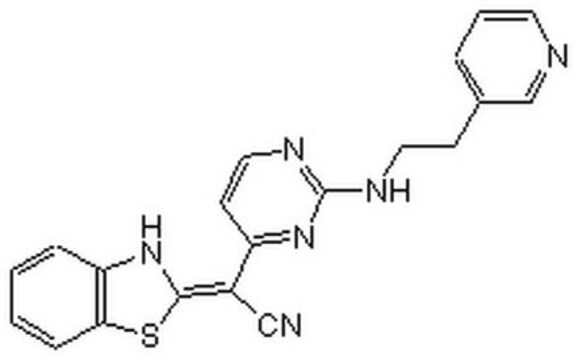124018
Akt Inhibitor VIII, Isozyme-Selective, Akti-1/2
Akt Inhibitor VIII, Isozyme-Selective, Akti-1/2, CAS 612847-09-3, is a cell-permeable, reversible inhibitor of Akt1/Akt2 (IC₅₀ = 58 nM, 210 nM, & 2.12 µM for Akt1, Akt2, and Akt3, respectively).
Synonim(y):
Akt Inhibitor VIII, Isozyme-Selective, Akti-1/2, 1,3-Dihydro-1-(1-((4-(6-phenyl-1H-imidazo[4,5-g]quinoxalin-7-yl)phenyl)methyl)-4-piperidinyl)-2H-benzimidazol-2-one, Akti-1/2
About This Item
Polecane produkty
Poziom jakości
Próba
≥95% (HPLC)
Postać
solid
producent / nazwa handlowa
Calbiochem®
warunki przechowywania
OK to freeze
protect from light
kolor
yellow
rozpuszczalność
DMSO: 5 mg/mL
Warunki transportu
ambient
temp. przechowywania
2-8°C
InChI
1S/C34H29N7O/c42-34-39-26-8-4-5-9-31(26)41(34)25-14-16-40(17-15-25)20-22-10-12-24(13-11-22)33-32(23-6-2-1-3-7-23)37-29-18-27-28(36-21-35-27)19-30(29)38-33/h1-13,18-19,21,25H,14-17,20H2,(H,35,36)(H,39,42)
Klucz InChI
BIWGYFZAEWGBAL-UHFFFAOYSA-N
Opis ogólny
Działania biochem./fizjol.
Akt1, Akt2, Akt3
Opakowanie
Ostrzeżenie
Rekonstytucja
Inne uwagi
Logie, L., et al. 2007. Diabetes56, 228.
Barnett, S.F., et al. 2005. Biochem. J.385, 399.
DeFeo-Jones, D., et al. 2005. Mol. Cancer Ther.4, 271.
Zhao, Z., et al. 2005. Bioorg. Med. Chem. Lett.15, 905.
Lindsley, C.W., et al. 2005. Bioorg. Med. Chem. Lett.15, 761.
Informacje prawne
Kod klasy składowania
11 - Combustible Solids
Klasa zagrożenia wodnego (WGK)
WGK 3
Temperatura zapłonu (°F)
Not applicable
Temperatura zapłonu (°C)
Not applicable
Certyfikaty analizy (CoA)
Poszukaj Certyfikaty analizy (CoA), wpisując numer partii/serii produktów. Numery serii i partii można znaleźć na etykiecie produktu po słowach „seria” lub „partia”.
Masz już ten produkt?
Dokumenty związane z niedawno zakupionymi produktami zostały zamieszczone w Bibliotece dokumentów.
Klienci oglądali również te produkty
Nasz zespół naukowców ma doświadczenie we wszystkich obszarach badań, w tym w naukach przyrodniczych, materiałoznawstwie, syntezie chemicznej, chromatografii, analityce i wielu innych dziedzinach.
Skontaktuj się z zespołem ds. pomocy technicznej














![PERK Inhibitor I, GSK2606414 GSK2606414 is a cell-permeable, highly potent inhibitor of EIF2AK3/PERK (IC₅₀ = 0.4 nM; [ATP] = 5 µM). Targets PERK in its inactive DFG conformation at the ATP-binding region.](/deepweb/assets/sigmaaldrich/product/structures/180/559/efa716dc-d5fe-4339-a6f0-0103084fc04a/640/efa716dc-d5fe-4339-a6f0-0103084fc04a.png)
